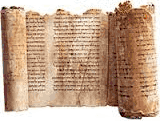Classics and Religious Studies, Department of

Sidnie White Crawford Publications
Date of this Version
2016
Document Type
Article
Citation
Published in The Dead Sea Scrolls at Qumran and the Concept of a Library. Eds. S. W. Crawford and C. Wassen; Leiden/Boston: Brill, pp. 1-3.
Abstract
In the early years following the discovery the manuscripts in the eleven caves in the vicinity of Khirbet Qumran many scholars casually used the term “library” when referring to the Qumran Scrolls. F.M. Cross, for example, entitled his 1958 survey The Ancient Library of Qumran and Modern Biblical Studies, while J.T. Milik named chapter two of his Ten Years of Discovery in the Wilderness of Judaea “The Qumrân Library.”1 More recently authors have shied away from the word “library,” preferring the more neutral terms “corpus,” “collection,” or simply “scrolls.”2 However, the question of whether or not the corpus of manuscripts unearthed in the Qumran caves constitute a library has ramifications for how those scrolls are understood, the purpose of the settlement at Qumran, the identity of the inhabitants of Qumran, and when and why the scrolls were deposited in the caves. Therefore, the aim of this volume is to examine the question of whether or not the Qumran corpus constituted a library through a variety of lenses, taking into consideration historical, literary and archaeological/ material evidence in an attempt to arrive at a conclusion. But any reader hoping to find a definitive answer will be disappointed, since it will become apparent that not all the scholars represented in this volume agree. This is, we feel, as it should be with any question for which the available evidence is so partial and fragmentary, as is the evidence of the Qumran scrolls.
Included in
Classical Literature and Philology Commons, Jewish Studies Commons, Near Eastern Languages and Societies Commons


Comments
© Koninklijke Brill NV, Leiden, 2016
DOI 10.1163/9789004305069_002